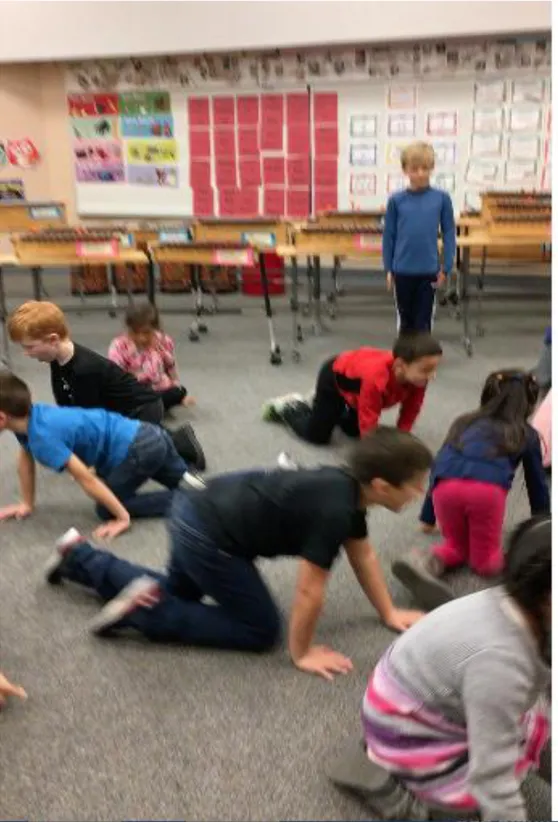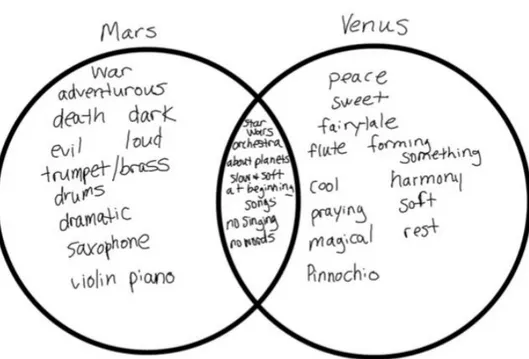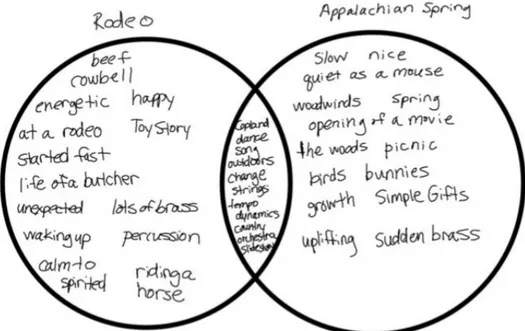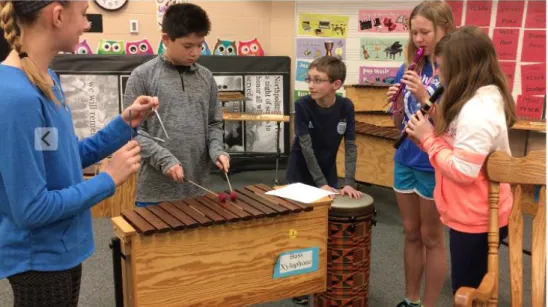PIERPAOLO POLZONETTI - MAGGIE YOUNGBLOOD Davis, California -Granger, Indiana
TEACHING HUMANITIES AND SCIENCE
THROUGH MUSIC IN PRIMARY EDUCATION
PIERPAOLO POLZONETTI – Part I: Teaching through Music in Theory
My collaboration with Maggie Youngblood began after a seminar-workshop I offered to teachers in elementary, middle and high schools, titled “Teaching Through Opera”. The seminar was part of an exchange initiative of the University of Notre Dame called “Teachers as Scholars”. As the title “Teachers as Scholars” suggests, the project aimed at encouraging scholarship in teaching, as well as teaching as a way to advance scholarship through collaborative work between pre-college and college educators.1
My approach to the seminar, as suggested by the title, “Teaching through Opera”, was meant to involve teachers specialized in different disciplines – social sciences, sciences, language arts, and music – to use opera as an arena to foster interdisciplinary connections, dismantle compartmentalized acquisition of skills, and let music contribute at best to a well-rounded education. Before and after this workshop I was involved in teaching opera in elementary schools to better understand the challenges educators face in their daily interaction with children under ten years of age.2 At the cost of stating a truism, I came to the full
realization of how teaching in elementary school cannot be done without theoretically informed practice and without the help of specialized teachers who have acquired the knowledge of how to teach in the age-appropriate style for each group of students. This requires advanced pedagogical skills and the experience and ability necessary to understand children’s appropriate pace and
1 Teachers as Scholars (TAS) is a program of the University of Notre Dame that
partners with the South Bend Community School Corporation. The program provided me the opportunity to teach and collaborate with local teachers. I am grateful to Jay Caponigro, Director of Community Engagement at Notre Dame, for his enthusiastic support, and to my former assistant Lesley Sullivan for helping me with this project. To learn more about this program see https://publicaffairs.nd.edu/programs/teachers-as-scholars/ (last accessed, 30.09.2019).
2 I offered opera classes at Perley Primary Fine Arts Academy, an elementary
school in South Bend, Indiana, in 2016. In 2017 I observed Maggie Youngblood’s classes at Northpoint Elementary School in Granger, Indiana. In 2018 I also offered classes at Patwin Elementary School in Davis, California. I am grateful to Lesley Sullivan who also assisted me in the class at Perley and to the teachers who worked with me, especially Jeannie Pedersen-Smith and Erin Harding at Perley, and Vicki Rinne at Patwin.
modes of learning.3 Maggie Youngblood, who masters these skills in the
classroom, took ideas I introduced in my seminar on “Teaching through Opera” and made a further step ahead by applying the concept to music in general. I learned a good deal observing her 3rd-grade classes. Children sit on a carpet,
surrounded by musical instruments. Classes continuously alternate between activities of playing, listening, moving, and writing about music - she uses interactive technology called “Easy Interactive Tools”, allowing traditional whiteboards to function like a tablet by manipulating content projected on the wall using digital pens. I was amazed to see the high verbal, motor, scientific, and mathematical skills children acquire through music.
Teaching through music is a controversial approach in music education. As Bennett Reimer reminds us, the so called “aesthetic education” has heavily informed American (and not only American) pedagogy of music at every level from early development to University since the 1960s.4 Philip Alperson points
out how “aesthetic education” is grounded on Eduard Hanslick’s idea of absolute music, generating a “strict formalist emphasis” in teaching arts, including visual arts, especially in public schools, and a “cluster of concepts” in the educational approach to music, resulting in a familiar arsenal of ideologically charged terms, including “disinterested perception”, “music appreciation”, “originality”, “genius”, “masterpiece”, and “connoisseurship”.5 The bottom line
is the idea that music should be experienced in itself, for its own sake and value, in order to contemplate the sublimity of its creators. In radical aesthetic education contextual and representational qualities are ignored or banned as corruptive of music’s absolute beauty. The result is the isolation of music as a discipline in education, which is hurting the perception of its function, or rather lack thereof, in the core curriculum.
A new, different approach is encouraged, among others, by Wayne Bowman, who calls attention to the “tremendous difference between educating in and educating through music”. Educating through music, requires a new kind of music educator who – Bowman writes - is not only a “music specialist”, but someone who “recognizes and responds to the plurality and diversity of students’ needs and those of an ever-changing society”. The reason why teaching through music is a more effective approach to integrate music in general
3 The inspiration to teach opera in elementary school came from Silvia Cancedda,
“Ascolto e comprensione dell’opera: due percorsi didattici per la scuola primaria,” in Insegnare il melodramma: saperi essenziali, proposte didattiche, ed. by G. Pagannone, Lecce, Pensa, 2010, pp. 99-144.
4 B.REIMER, A Philosophy of Music Education: Advancing the Vision, 3rd edition, Upper
Saddle River, NJ, Prentice Hall, 2003, pp. 8-9. Reimer remains an advocate for “aesthetic education” even though he is opposed to a dogmatic approach to it.
5 PH. ALPERSON, “What Should One Expect from a Philosophy of Music
Education?”, The Journal of Aesthetic Education, XXV, n. 3, 1991, pp. 215-242: citation on p. 219.
education is that, quoting Bowman again, “specialized training for a ‘talented’ few, which passes for music education in many parts of the ‘developed’ world, is hardly the kind of instruction that benefits all – the general student, or society at large”.6 In order to promote ‘learning through music’ as a way to “explore the
possibilities for using music to access the wider school curriculum”, Alison Daubney encourages “double-focus” learning: first acquisition of advanced skills in separate disciplines and then the combination and merging of skills.7 This
approach has been theorized by Jonathan Barnes, who recognizes the importance of music, along with art and drama, as fertile fields for cross-curricular learning.8 Barnes also sees the risk of “hierarchical cross-curricular”
approaches, observing that, “the danger is that in thematic curricula some disciplines like Music, Art, Dance […], may become cast forever in this subservient, serendipitous and submissive role”.9 For this reason, he prefers
instead a more horizontal “interdisciplinary cross-curricular” approach.10 The
case studies involving music Barnes proposes in Cross-Curricular Learning are nevertheless somewhat disappointing, privileging making music to promote “development of language and communication with emotional and social health” through creating and performing lullabies; the “involvement in practical music activity to “develop skills of coordination, confidence, and an understanding of pattern and structure”; or, the use of music to manage emotions. 11 This approach is indebted to the kind of cognitive theory promoted,
among others, by Juslin and Sloboda.12
6 W.D.BOWMAN, “Music’s Place in Education,” in An Oxford Handbook in Music
Education, 2nd edition, 5 vols., vol. 1, Music and Music Education in People’s Lives, Oxford,
Oxford University Press, 2018, pp. 19-37: 25-29 (emphasis added). For a similar position, encouraging “creative thinking” and “interdisciplinary connections”, see Peter R. Webster’s “Foreword” to Patrick Schmidt and Richard Colwell (eds.), Policy and the Political Life of Music Education, Oxford, Oxford University Press, 2017, pp. ix-xvi: xi. This volume collects essays with refreshing international perspectives, but there are virtually no signs of a real intention to apply Webster’s ideas to actual policies. A position more clearly in favor of interdisciplinary approach to music in view of forming a well-rounded education is advocated and better articulated by C. DETELS, Soft Boundaries: Revisioning the Arts and Aesthetics in American Education, Westport, CT, Bergin and Garvey, 1999.
7 A.DAUBNEY, Teaching Primary Music, London, SAGE, 2017, chapter 9, pp. 136-149.
8 J.BARNES, Cross-Curricular Learning 3-14, 3rd edition, London, SAGE, 2015, p. 59.
9 Ivi, pp. 66-67. 10 Ivi, pp. 72-75.
11 Ivi, pp. 88-89, 140-141, 155.
12 Music and Emotion: Theory and Research, ed. by P. N. Juslin and J. A. Sloboda,
Oxford, Oxford University Press, 2001, and their other edited volume, Handbook of Music and Emotion: Theory, Research, and Applications, Oxford, Oxford University Press, 2010.
Teaching humanities, social sciences, and sciences through music is highly praised in theory but remains counter-current in practice and does not reflect the general position of the US National Association of Music Education.13 Yet,
there is some new hope. As Campbell and Kassner point out in their last book, the Association for Supervision and Curriculum Development (ASCD) encourages the integrated curriculum, which empowers students to make connections across disciplines. For Campbell and Kassner “integrating curricula […] helps children learn the standards of each discipline and connect common ideas across disciplines”. The risk is illusionary integrated curricula occur when teachers fall into the trap of “infusion”, which happens when a discipline becomes subservient of another, as in the case of teaching the alphabet song, hence using music as an aid to memorize letters. Instead of “infusion”, then, teachers should practice “integration”, which “leads students to a greater understanding of each subject involved and shows equal respect for the value of all disciplines”.14 Maggie Youngblood practices learning through music as well
as music learning in primary education through both making and listening to music, overcoming the false dichotomy, emphatically denounced by Giuseppina La Face, between “far musica” and “ascoltare”, too often misunderstood as a dichotomy between making music, upheld as active learning vs. listening, mispresented as passive learning.15
MAGGIE YOUNGBLOOD – Part II: Teaching through Music in Practice
I would like to relate what I do, in practice, with my students in order to allow them to develop skills for the study of the humanities and sciences through music. My approach does not imply any imposition of knowledge in order to understand music or other disciplines. Rather, I hope to stimulate students to think outside the box and to develop imagination and creativity in music making and music listening. For this reason, my methodology for teaching music in primary school is diverse and diversified. In class my primary goal is to expose
13 The attitude dominating the National Association of Music Education
(NAfME), former Music Educators National Conference (MENC) is to advocate the right to provide music education for every child, while there is virtually no emphasis on the need to promote a kind a music education that is conversant with other disciplines in the chore curriculum: see the “Centennial Declaration of MENC” (2007), in https://nafme.org/about/history/menc-centennial/a-centennial-declaration-of-menc-the-national-association-for-music-education/ (last accessed, 30.09.2019), and Music Education at a Crossroad: Realizing the Goal of Music for All, ed. by J. R. Barrett, MENC, The National Association for Music Education, 2009.
14 P. S. CAMPBELL - C. SCOTT-KASSNER - K. KASSNER, Music for Elementary
Classroom Teachers, New York and London, Norton, 2017, pp. 21-22.
15 G.LA FACE BIANCONI, “La musica e le insidie delle antinomie,” in La musica tra
conoscere e fare, ed. by G. La Face Bianconi and A. Scalfaro, Milan, FrancoAngeli, 2011, pp. 11-23.
students to as many different activities as possible, including, but not limited to, singing, playing instruments, reading, writing, improvising, composing, listening to, describing, and movement, including dancing to music. How do we instruct our students to talk about, think about, and write about music? In the United States, at both the elementary and secondary level, there is a heavy emphasis on music as a performance class. I am also convinced that in order to acquire status as a core subject in our education system, music needs to be considered a part of a much larger educational score, which includes language and literature (English), sciences, and history.
Pierpaolo Polzonetti and I met to discuss a project, or set of lessons, to focus on bringing more classical music studies to the elementary music classroom, and also to focus on how we think about, talk about, and write about music. After discussing these ideas, I came up with a list of classical-music pieces that would be both enjoyable and engaging for my students to listen to, and that would allow us to make cross-curricular connections. I choose pieces for my classes based on their potentials to allow students to make connections between the music itself and other realms of perception and knowledge so that students not only learn through music but also learn music through other acquired areas of knowledge or through other non-musical skills.
For first-grade students I chose The Carnival of the Animals by Camille Saint-Saëns. Chiara Sintoni, in her article in this journal about teaching The Carnival of the Animals to elementary-school students, convincingly shows how this collection of small pieces for chamber orchestra can be a formidable tool to introduce children to attentive listening. She proposes to use guided movements and gestures in order to allow children to develop the ability to recognize structural parameters of music, such as pitch content, dynamics, pace and note lengths, large-scale forms, small-scale periodicity, phrasing, rhythmic cells, etc.16
Sintoni recognizes how corporality is connected to intellectual dimension, which justifies how the corporal dimension can be effective for the development of the understanding of music in order to produce “reflective listening” (“ascolto riflessivo”), which is based on “understanding” music itself “objectively”, “rationally”, and “competently”, as opposed to “projective listening” (“ascolto proiettivo”), which is based on projecting subjective responses in the attempt to make sense of what any music piece is about.17
Sintoni’s approach is useful and very effective as a way to allow students to grasp how music works. The way I use Saint-Saëns’s and other pieces discussed
16 C. SINTONI, “Gesto e movimento per la comprensione musicale. Ascolto dal
‘Carnevale degli animali’ di Camille Saint-Saëns”, this journal, II, 2012, pp. 123-139, https://musicadocta.unibo.it/article/view/3225 (last accessed, 30.09.2019). I thank Pierpaolo Polzonetti for helping me translate this article. This paragraph reflects our discussion of its content in relation to our collaborative project.
17 SINTONI, “Gesto e movimento”, pp. 123-125, based on theoretical concepts
below is informed by the idea of teaching not only music, but also through music. My goal is to allow students to use knowledge they already have when approaching a new thing, like symphonic music. Most six- and seven-year-old children have had experiences with animals, whether with pets, wild animals (in Indiana we have many visiting our backyards), or in the local zoo. Through their acquired knowledge the music itself will appear more familiar, and this music can also stimulate them to reflect on elementary notions of zoology. The other advantageous aspect of using this suite for first graders is the fact that all of the pieces are relatively short. I knew it would be a challenge to get the children to listen to something longer than a few minutes. Like in the case of Sintoni, one skill I wanted them to develop is to associate animals with concepts of movement, at first movement of bodies in space and then purely musical movement as rhythmic pace and tempo. I also encourage students to make connections between music terminology and extra-musical referents, such as visual or personality characteristics of different animals, or non-musical sounds, like animal sounds. For example, after listening to “Royal March of the Lion” I asked the students to move around the room like a lion, highlighting the glissando in the music that represents the lion’s roar (see Fig. 1).
Figure 1 – First-grade students enacting the “Royal March of the Lion” from The Carnival of the Animals by Camille Saint-Saëns.
After we listened to both “Lion” and “Elephant”, I asked the students to illustrate an animal other than a lion or elephant and write a sentence, describing how that animal could fit with the music, even though it is a different animal than they had to associate to this music. This way I encouraged students to break free from the univocal association of one movement with one animal and open up to a more creative but still analytically informed listening experience.
For students age 7 to 8 (2nd grade) I chose Holst’s The Planets. By age 7-8,
most students are familiar with space and the various celestial bodies.18 In our
school, they have also visited the planetarium and the Star Wars saga is their equivalent of Homer’s Iliad or Virgil’s Aeneid. Each class brainstormed a list of ideas that the piece “Mars” could be about. The only prerequisite information I gave them was that the topic had something to do with science. Rather than teaching them scientific facts about Mars and its mythology first, and then introducing the music, I started with the music and had them come up with thematic ideas based on what they heard. Using the music to teach through the subject, instead of teaching about the subject, is a much more engaging process for children of this age. I used the piece to teach them to listen critically to the music; I did not project the thematic content of the song onto them before listening (in this case, “The Bringer of War”). The factual knowledge about the music, and its scientific source material, came last, and it showed the students that they were in tune with what was happening in the music and that they were on the right track in their observations of the thematic content – many of them mentioned fighting, war, or Star Wars in their initial observations. After listening to both “Mars” and “Venus”, we made a Venn diagram as a class to compare the pieces (see Fig. 2).
18 J.R.FALLIN -M.G.TOWER, Using Music to Enhance Student Learning: A Practical
Guide for Elementary Classroom Teachers, New York and London, Routledge, 2015, pp.138-139.
Figure 2 – Venn diagram comparing “Mars” and “Venus” from Holst’s The Planets. Their observations astounded me. They were very perceptive to things happening in the music and ideas that were both similar and different between the two pieces. Splitting up into smaller groups of two or three, I asked the students to come up with creative movements to characterize either Mars or Venus. We discussed what types of movements would be a good fit with each piece before attempting this task.
For third grade, I used material from Pierpaolo Polzonetti’s workshop to introduce the students to opera, namely Rossini’s Cenerentola, and develop literary skills about fairy tales, plot and dramatic development, and so on. In this instance, we started by brainstorming the main characteristics of a fairytale, from their work in language arts classes and their own personal experiences. They expressed thematic ideas such as good triumphing over evil, magic, love stories, and sometimes even talking animals. From there, we set out to write our own fairytales, both as a class and individually. What interested me most, though, was the ability to make these connections while listening to purely instrumental music, namely the overture of the opera, and encourage students to recount their story based on the music. We used the overture to Rossini’s Cenerentola as a sort of film score set to the narration of their stories, which was something they really enjoyed. It was amazing how well their plot elements matched the pace and mood of the orchestral moments of the overture!
Finally, for fifth grade, my focus is to approach social studies through music. Social studies receives a lot of attention in our fifth-grade curriculum and I
wanted to include a topic that they were already studying in their regular classrooms. I chose Appalachian Spring and Rodeo by Aaron Copland, as each tackles the subject of the American West and westward expansion in different ways.19 Venn diagrams and T opinion graphs help in this case to compare
different pieces about the same topic and abstract the idea of the American West emerging from Copland’s music (see Fig. 3).
Figure 3 – Venn diagram comparing Copland’s Rodeo and Appalachian Spring.
The difference now is the introduction of geographical space, especially the openness of the West, so well reflected in Copland’s music, but also historical contextualization – how that idea of space reflected the American mentality, and the social problems involved in taking that space, especially in taking it away from Native Americans. This social approach does not preclude a creative approach, both in listening, moving and making music. For example, I asked the students to recreate or imitate either Appalachian Spring or Rodeo with a mix of instruments (see Fig. 4). I found that students learn more thoroughly through music when making music, once they understand the cultural and historical context of a specific composition.
Figure 4 – Students recreating concepts studied through Copland’s Appalachian Spring and Rodeo using different instruments.
To summarize all four units of study, I strongly believe that in listening to and discussing both the conceptual framework behind these pieces and the cross-curricular connections to which they were related, my students gained a better understanding of musical topics such as form, composition, and movement, while simultaneously strengthening their learning and understanding of science, language, and history. The students are at the forefront of producing the knowledge about these various subjects; the knowledge is not given to them ahead of time so that they can regurgitate the knowledge in connection to the music. Rather, they make discoveries about their own knowledge base and their own intuition about the classical music pieces as we learn together. Learning through music, while still accessing and approaching music standards, is an immersive, multidisciplinary approach to teaching that I plan to continue in the future. I should point out that there are many sources of learning theory and research behind this topic; this paper is simply a recounting of my practical teaching and learning experiences that took place with my students in my music classroom. My students were great sources of inspiration during these units of study, and it was exciting to see them process music and think about other topics of study in a new way.
PIERPAOLO POLZONETTI - MAGGIE YOUNGBLOOD – Conclusion
After working independently and in collaboration, we reached the conclusion that teaching through music, especially through an eclectic and holistic approach, does not preclude but enhances aesthetic appreciation. Active learning does not imply choosing between performing or listening, but it requires
engagement of as many physical and mental activities as possible. We should reflect more on the difference between active and creative teaching and the passive teaching that results from uncritical acceptance of abstract pedagogical tenets.



